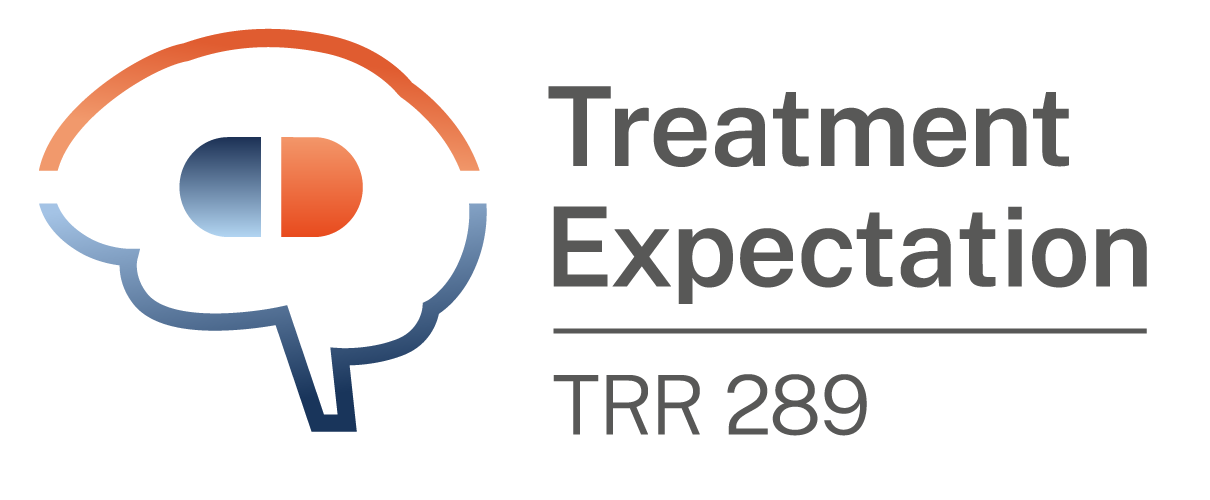Antonia Borcherding
Treatment of chronic low back pain: can social observation improve effects of pain medication or placebos?
Experimental and clinical studies suggest that positive expectations regarding pain treatment have a relevant pain-reducing effect in pain patients. The aim of our study is to investigate the optimization of treatment expectation in chronic low backpain (CLBP) patients by observing others. In our clinical trial (2x2 factorial design) we randomize CLBP patients to either a 3-week treatment with an analgesic, Metamizole (ANA), or to a 3-week treatment with open-label placebos (OLP). Treatment expectations are built through social observation, and their impact on these two treatments will be analysed. Accordingly, patients watch a positive or a neutral video. We assess patient’s treatment expectations before and after their 3-week treatment. We test effects of these expectations on subjective and objective outcome. An initial analysis with two-sided t-testing of 46 patients shows a significant decline in pain ratings in both OLP-groups and in the ANA-group without social observation. The ANA-group with social learning shows no significant pain reduction. The initial results may suggest that social observation has a better effect in the OLP-group than in the ANA-group. However, this result should be interpreted with caution.
Charlotte Krahe (virtual)
Updating beliefs about pain following advice: Trustworthiness of social advice predicts pain expectations and experience
Prior expectations about pain influence pain experience. Although social context is critical in shaping pain, previous research has mainly focused on the pain-modulatory role of own rather than social expectations. We studied effects of explicitly communicated social expectations (‘advice’) on pain. N = 72 female participants undertook a cold water task before and after receiving advice about their likely pain tolerance from a confederate. We examined how participants changed (1) their own pain expectations and pain tolerance based on the advice, and (2) their future pain expectations (prospective posterior beliefs) based on the combined effect of the advice on their expectations, and their experience. Further, we manipulated perceived trustworthiness of the confederate (high; low) to investigate how varying the uncertainty of advice would impact the above measures. Participants adjusted their pain expectations towards the social advice more in the high vs. low trustworthiness condition, and greater advice taking predicted greater pain tolerance. In the high trustworthiness condition, advice increased the precision of prior beliefs relative to precision of new sensory evidence, and less learning was achieved by new sensory evidence. Conversely, advice from a less trustworthy source rendered prior beliefs more uncertain, and more learning was achieved from sensory evidence.
Ilenia Ceccarelli
Sharing pain: nocebo and placebo effects in a group context
Social context plays a crucial role in both placebo and nocebo responses. In a social shared aversive condition, this study investigated the contribution of individual (i.e. pain expectations, social and pain-related personality factors) and group features (i.e. pain tolerance, level of group identification, the quality and strength of the relationship between members, level of trust) in shaping pain perception.
Sixty-one university students (33 women) of the same class were randomly subdivided in 10 groups and underwent an experimental pain induction (i.e. cold pressure test). Pain tolerance, pain threshold, pain intensity and autonomic reactivity to nociceptive stimulation were assessed. The average pain intensity was significantly higher when participants were members of a group where at least one person stopped the procedure before its end. Regression analysis indicated that individual pain expectations and the strength of the relationship with group members are significant predictors of pain intensity. Individual’s fear of pain and group relationship predicted mean heart rate and sympathovagal balance during procedure.
Sharing with meaningful others an experience of pain seems to be able to influence individual pain perception and the general adaptation to the aversive condition.
Stefanie Meeuwis
Placebo stories: people’s experiences with placebo effects in daily life
Experimental studies show that placebo effects can improve somatic symptoms including pain. In these studies, suggestions or learning procedures are often applied that explicitly trigger effects. Little is known about situations outside of the laboratory, for instance, whether people notice and utilize placebo effects in daily life. This semistructured survey study aimed to evaluate people’s experiences with placebo effects in daily life. Qualitative and quantitative questions mapped multiple aspects of placebo effects, including their frequency, their affected symptoms/conditions and purported cause.
192 respondents completed the survey, of whom 110 (57.3%) indicated they experienced a placebo effect before and 19 (10.2%) observed it in others. Effects were reported most often in somatic symptoms (76.2%; eg, immediate pain relief after taking a painkiller) or wellbeing (68.5%; eg, feeling less stressed). Possible explanations that people provided for the placebo effects included information from others (eg, parents advising home-remedies), hope for pain relief, a positive mindset and trust in the healthcare professional.
Over half of the respondents indicated that they experienced/observed placebo effects in daily life. This provides opportunities for translating experimental effects into ecologically valid methods to maintain placebo effects, for instance in clinical practice.



